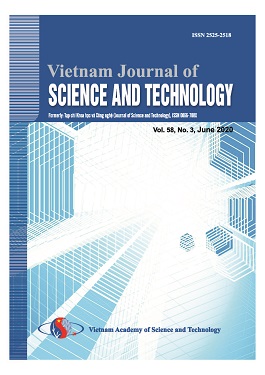Creep analysis of concrete columns by using finite element method
Author affiliations
DOI:
https://doi.org/10.15625/2525-2518/58/2/14000Keywords:
creep, viscoelastic, CFST, concrete, Prony series, AEMM, FEM, ANSYS.Abstract
The authors have carried out studies on long term behavior of concrete-filled steel tubular (CFST) column by numerical methods based on experimental data that is described by a visco-elastic model, and the age-adjusted effective modulus (AAEM) method is adopted to modeling creep behavior of the concrete core, which is evaluated by the Finite Element Method (FEM) combined Prony's series interpolation by using ANSYS software. The CFST column with circular sections under long term sustained loading are performed, ensure the ultimate load bearing capacity of the members is limited to cause cracks. In the material modeling, the confining effect of the concrete was taken into account while the steel was modeled as a bilinear kinematic hardening model with perfect bond between concrete and steel. The scope of applicability, advantages over other methods and limitations are discussed in detail.
Downloads
References
HaiYang Wang, XiaoXiong Zha, and Wei Feng, “Effect of Concrete Age and Creep on the Behavior of Concrete-Filled Steel Tube Columns,” Advances in Materials Science and Engineering, vol. 2016, Article ID 7261816, 10 pages, 2016.
Yeong-Seong Park, Yong-Hak Lee, and Youngwhan Lee, “Description of Concrete Creep under Time-Varying Stress Using Parallel Creep Curve,” Advances in Materials Science and Engineering, vol. 2016, Article ID 9370514, 13 pages, 2016.
S.H. Kwon, Y.Y. Kim, J.K. Kim, Long-term behaviour under axial service loads of circular columns made from concrete filled steel tubes, Mag. Concr. Res. 57 (2) (2005) 87–99.
Ichinose LH, Watanabe E, Nakai H. An experimental study on creep of concrete filled steel pipes. J Constr Steel Res 2001;57(4):453–66.
ACI 209R-92. Prediction of creep, shrinkage and temperature effects in concrete structures. American Concrete Institute, Farmington Hills, MI, 1992.
Bazant, Z.P. Prediction of concrete creep effects using age-adjusted effective modulus method, Jounal Proceedings., vol. 69, pp. 212-219, 1972.
Wang YY, Geng Y, Ranzi G, Zhang SM. Time-dependent behaviour of expansive concrete-filled steel tubular columns. J Constr Steel Res 2011;67(3):471–83.
Han LH, Yang YF. Analysis of thin-walled steel RHS columns filled with concrete under long-term sustained loads. Thin-Walled Struct 2003;41(9):849–70.
Naguib W, Mirmiran A. Creep modeling for concrete-filled steel tubes. J Constr Steel Res 2003;59(11):1327–44.
Liu H, Wang YX, He MH, Shi YJ, Waisman H. Strength and ductility performance of concrete-filled steel tubular columns after long-term service loading. Eng Struct 2015;100:308–25.
P. Shokouhi, A. Zoega, and H. Wiggenhauser, “Nondestructive ¨ investigation of stress-induced damage in concrete,” Advances in Civil Engineering, vol. 2010, Article ID 740189, 9 pages, 2010.
G. T. Liu, H. Gao, and F. Q. Chen, “Microstudy on creep of concrete at early age under biaxial compression,” Cement and Concrete Research, vol. 32, no. 12, pp. 1865–1870, 2002.
Geel, van, H. J. G. M. (1998). Concrete behaviour in multiaxial compression: experimental research Eindhoven: Technische Universiteit Eindhoven DOI: 10.6100/IR515170.
Tschoegl, N. W., The Phenomenological Theory of Linear Viscoelastic Behavior, Springer, Berlin, 1989.
Christensen, R. M., Theory of Viscoelasticity, Academic Press, New York, 1971.
Drienovská, Jana., and Tvrdá, K., Deflection of a Beam Considering the Creep, Procedia Engineering., vol. 190, pp. 459 – 463, 2017.
Neville, A. M., Dilger, W. H. and Brooks, J. J., 'Creep of Plain and Structural Concrete' (Construction Press, Longman Group, 1983).
Gilbert, R. I., 'Time Effects in Concrete Structures' (Elsevier Science, Amsterdam, 1988).
Downloads
Published
How to Cite
Issue
Section
License

This work is licensed under a Creative Commons Attribution-ShareAlike 4.0 International License.
Vietnam Journal of Sciences and Technology (VJST) is an open access and peer-reviewed journal. All academic publications could be made free to read and downloaded for everyone. In addition, articles are published under term of the Creative Commons Attribution-ShareAlike 4.0 International (CC BY-SA) Licence which permits use, distribution and reproduction in any medium, provided the original work is properly cited & ShareAlike terms followed.
Copyright on any research article published in VJST is retained by the respective author(s), without restrictions. Authors grant VAST Journals System a license to publish the article and identify itself as the original publisher. Upon author(s) by giving permission to VJST either via VJST journal portal or other channel to publish their research work in VJST agrees to all the terms and conditions of https://creativecommons.org/licenses/by-sa/4.0/ License and terms & condition set by VJST.
Authors have the responsibility of to secure all necessary copyright permissions for the use of 3rd-party materials in their manuscript.







 Vietnam Journal of Science and Technology (VJST) is pleased to notice:
Vietnam Journal of Science and Technology (VJST) is pleased to notice: